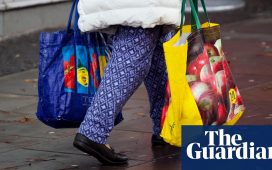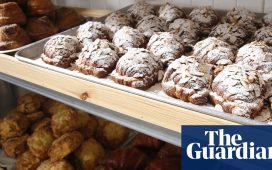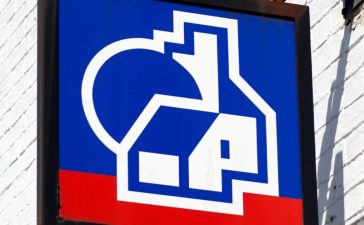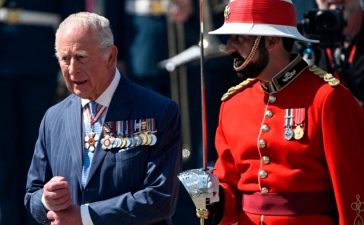The hidden irony of A Grand Day Out, the animation that launched Wallace and Gromit, is that a 1950s Yorkshireman in search of a cracking wensleydale might just as well have looked for it on the moon.
Wensleydale, like most British cheeses other than cheddar and stilton, was almost destroyed in the postwar drive towards mass production. Fortunately, some of the centuries-old recipes for those lost cheeses were preserved, and a growing number of artisans are starting to make them again, from Wensleydale to Lancashire and Bangor to Ceredigion.
Carrie Rimes’s Caws Chwaral, or quarry cheese, is based on cheeses made in north Wales farmhouses – a Caerphilly recipe that is nothing like the crumbly white cheese normally associated with the name.
“Nobody was making anything like this,” said Rimes, who set up Cosyn Cymru after learning cheesemaking in France. “Here in the north-west it would appear that it was largely subsistence farming, producing cheese for the family.”
Cheese was traditionally a way for farmers to preserve leftover milk, especially for the winter months. Britain once had thousands of farmhouse cheeses, but they dwindled first when the acts of enclosure pushed smallholders off the land, then when the Industrial Revolution encouraged producers to ditch long-maturing cheeses in favour of quick ones.
But it was the second world war that led to the most existential crisis for small cheesemakers. During rationing, milk was reserved in greater amounts for drinking, and cheese could be imported.
“In 1939, there were about 220 raw-milk Lancashire makers,” said Angus Birditt, author of A Portrait of British Cheese. “Until last year, there was only one – Kirkham’s.”
Since March there has been another: Lowfields, a creamy Lancashire cheese by Roger Cowgill, from his herd of 12 Dairy Shorthorns.
“Kirkham’s kept it going,” he said. “We’re the second and the newest for a very long time.” The recipe is from a 1930s Ministry of Agriculture and Fisheries (Maf) booklet. “It gives cheeses from all the regions of Britain and a recipe and a bit of a write-up. We’ve made little tweaks for it to work in our dairy and with our milk.”
The growth of artisans like Cowgill means Britain is regaining something the French never lost – a terroir of cheese where the same recipe will produce different flavours due to the breed of cows, the pasture they graze and the cellars the cheese is matured in.
Wensleydale Creamery kept the cheese alive when raw milk was deemed too risky to use, but now there are three artisan cheesemakers in the dales making recipes that had long been forgotten: Yoredale by Samantha and Ben Spence, Fellstone by Clare and Tom Noblet, and Stonebeck by Sally and Andrew Hattan.
“We have 50 acres that are recognised as species rich,” said Sally Hattan. “We’ve got 80 different species of wildflower plus grasses – and it really does come through in the flavour, the texture, the colour. We can even tell as we move the cows from one pasture to another.”
The Hattans used a combination of old Maf literature and work by Marie Hartley and Joan Ingilby, who went round the Yorkshire Dales in the 1950s trying to document some of the traditional crafts that were being lost.
They make six tonnes of Stonebeck a year now, their fifth year of production, but only from when it is in season – starting in the spring after the cows have calved and stopping in October when they let the herd go dry for the winter.
The cows are Northern Dairy Shorthorns – “a rare breed, but native to here,” Hattan said. “There’s about 250 breeding females now, and we probably have about 10% of the population. People had just kept them going, but there wasn’t an established milking herd until we brought them together.”
In the early days of Stonebeck, Sally Hattan found one of the few surviving cheesemakers who remembered the original tastes, a farmer called Mabel Peacock, who died in 2018 aged 103. “She was thrilled to see pictures of our cows,” she said. “She remembered making cheese with her mum in Richmond – they had the same breed.”
after newsletter promotion
All the cheesemakers credit Randolph Hodgson for laying the groundwork by founding Neal’s Yard Dairy in London in 1979. His shop and others, including the Courtyard Dairy near Settle in Yorkshire and La Fromagerie in London, have championed new cheesemakers.
Patricia Michelson said she had seen cheeses come and go since founding La Fromagerie 33 years ago. “My reasoning was always to make your region, your place where you are making cheese, unique by the herd you are rearing,” she said. “Little by little, with encouragement, cheesemakers will find themselves in very specific regionality when it comes to making cheese, much like France, Italy and Spain.”
John Farrand, managing director of the Guild of Fine Food, said: “Ultimately ancient recipes give a cheesemaker a story and give their cheese a personality – and this leads into a broader point: food lovers are more interested in where their food has come from, who has made it, and want to engage in the personality behind the cheese.”
There are still plenty of recipes in the archives that remain untested, such as Suffolk bang, from about the 17th century, said Jonny Crickmore of Fen Farm Dairy and the Specialist Cheesemakers Association.
“It was made from skimmed milk,” he said. “It was so hard you could roll a cannon on it – the Royal Navy used to buy it because it was the only cheese the weevils couldn’t get into.
“The government actually asked the Suffolk farmers to stop producing it because it was giving British cheese a bad name. No one’s revived it yet.”










